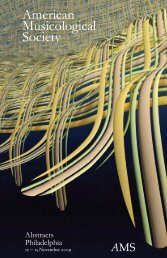Abstracts - American Musicological Society
Abstracts - American Musicological Society
Abstracts - American Musicological Society
Create successful ePaper yourself
Turn your PDF publications into a flip-book with our unique Google optimized e-Paper software.
30 Thursday Afternoon: Session 1- 26–27<br />
AMS/SEM/SMT New Orleans 2012<br />
Session 1-26 (SEM), 1:45–3:45<br />
Roundtable<br />
Publishing—A Dialogue for Young Scholars<br />
Jessica Getman (University of Michigan, Ann Arbor), Chair<br />
Mary Francis (University of California Press), J. Lawrence Witzleben (University of Maryland),<br />
Timothy Rice (University of California, Los Angeles), Sean Williams (Evergreen State University)<br />
In the changing academy, publication is of increasing concern to young scholars. The academic job market increasingly relies<br />
on a candidate’s history of publication as evidence of scholarly rigor and future success. At the same time, publication can<br />
seem daunting or inaccessible to the uninitiated writer, and though a scholar may have significant information and insight to<br />
share with the field, navigating the publishing process may be difficult. This roundtable addresses several concerns along these<br />
lines, including how to write and submit a successful article or chapter proposal, how to present a successful book proposal,<br />
how to write and mine the dissertation for successful publication, and how to best use publication to bolster the scholar’s job<br />
search and tenure portfolio. Our panelists will address how to best prepare a paper for publication consideration and how to<br />
contact and communicate with journal editors and acquisition editors from publishing houses. The roundtable will consider<br />
the hallmarks of a successful abstract, article, chapter, or book, and the ways in which various media can be used to the best<br />
effect in publication. In addition, it will consider the benefits and drawbacks of print versus digital publication. The roundtable’s<br />
panel brings together editors from academic publishing houses and journals with professional scholars with a history of<br />
successful publication in several formats. In so doing, it encourages a dialogue of particular benefit to aspiring ethnomusicologists,<br />
as well as historical musicologists and music theorists.<br />
Session 1-27 (SEM), 1:45–3:45<br />
Repatriation and Reclamation<br />
Lorraine Sakata (University of California, Los Angeles), Chair<br />
Heritage Extraction: Music and Memory in a Mining Town<br />
Bradley Hanson (Brown University)<br />
In 2001, Howard “Louie Bluie” Armstrong, a pioneering African-<strong>American</strong> stringband musician and National Heritage Fellow,<br />
became the center of a cultural heritage movement in LaFollette, Tennessee, the community where he was raised in the<br />
1920s. Though a success with folk music audiences and the subject of a well-received documentary film, Armstrong had been<br />
largely forgotten in the town he left as a young man. At age ninety-one, however, Armstrong was discovered and reintroduced<br />
to LaFollette by a group of residents organizing a cultural and economic coalition modeled on heritage, tourism, and “pride of<br />
place” industries. LaFollette, like many Appalachian coal mining towns, had by then earned a reputation for economic depression<br />
and social distress. Following the coalition’s marketing efforts and public events, the community, in an extraordinary act<br />
of collective remembering, reclaimed Armstrong and his legacy. Though he passed away in 2003 after just one celebrated return<br />
visit, Armstrong’s legend has since inspired a thriving yearly music festival, local exhibits, and community art projects. In<br />
his heritage afterlife, Armstrong serves as muse and brand for his former homeplace as it works toward cultural, social, artistic<br />
and economic renewal. Drawing on interviews and field research, I will offer a critical heritage case study at the intersection<br />
of remembering, forgetting, race, and expressive culture. Informed by the work of Laurajane Smith, Barbara Kirshenblatt-<br />
Gimblett, and Robert Cantwell, I show how one community is making something new from something old, and building a<br />
heritage infrastructure with complicated social engineering goals.<br />
“Repossessing the Land”: A Spiritual Retreat with Maher Fayez and a<br />
Movement of Coptic Charismatic Worship<br />
Carolyn Ramzy (University of Toronto)<br />
Over the last decade, Egyptian Coptic Christians have witnessed a vibrant surge in satellite religious programming. While<br />
the popular Coptic Orthodox Church Channel (CTV) represents Orthodox mainstream culture, Coptic Protestant channels<br />
such as SAT-7 present alternative views. As both feature live streaming of community worship, this paper addresses one<br />
worship convention as it was aired for SAT-7: famous Orthodox musician, Maher Fayez’s retreat “Repossessing the Land.”<br />
For three days, a mixed congregation of Orthodox Copts and Protestants sang Arabic devotional songs known as taratīl.<br />
Along with these impassioned musical worship sessions, Fayez invited three Ghanaian and Nigerian guests speakers from<br />
the Global Apostolic and Prophetic Network, an organization “dedicated to raising leaders in Africa and establishing the<br />
presence of God in every sphere of society,” (gapnetwork.org). Their sermons not only drew on Fayez’ original themes, but










